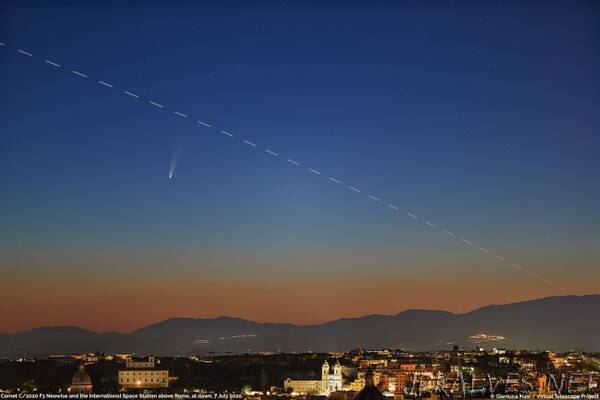
“An amazing comet that thrilled early-morning stargazers earlier this month is now visible in the evening sky, and it’s a sight you won’t want to miss. After all, this comet won’t be back for 6,800 years, NASA says.
Comet NEOWISE can now be seen just after sunset for observers in the Northern Hemisphere, according to NASA. (Sorry, Southern Hemisphere skywatchers, it’s not visible there.) The comet made its closest approach to the sun July 3 but was only visible before dawn until now.
“If you’re in the Northern Hemisphere, you can see it,” said Joe Masiero, deputy principal investigator of NEOWISE, the NASA space telescope that discovered the comet, in a NASA Science Live webcast Wednesday (July 15). “As the next couple of days progress, it will get higher in the evening sky, so you’re going to want to look northwest right under the Big Dipper.” (The Big Dipper is a ladle-shaped star pattern that is part of the constellation Ursa Major, the Big Bear.)
There are a few more comet-observing tips to keep in mind, according to Masiero.
First, you’re going to want to try and get away from city lights and set up in a location with a clear, unobstructed view of the northwest horizon.
Then, find out what time your local sunset is. (A tool like the Farmer’s Almanac or TimeandDate.com can help.) You’ll want to wait until 45 minutes after sunset before hunting the comet.
“What you want to do is go out right around the time that the first stars start to show up. You’re not going to be able to see it before that,” Masiero said. “It’s probably about as bright as some of the stars in the Big Dipper.”
To the unaided eye, Comet NEOWISE will look like a fuzzy star with a bit of a tail, according to a NASA guide. But binoculars or a small telescope offer a much better view.
Officially known as C/2020 F3, Comet NEOWISE was first discovered in March by the infrared-optimized NEOWISE spacecraft (the name is short for Near-Earth Object Wide-field Infrared Space Explorer). Since then, the comet has been spotted by several space telescopes and observatories, astronauts on the International Space Station and, of course, stargazers on Earth.
The light from the comet is sunlight reflecting off the dazzling tail of gas and dust trailing away from NEOWISE as it drifts ever farther from the sun. A second tail made of ionized particles blown back from the comet’s head (called its “coma”) by the solar wind can be seen in some photos.
“This comet is about 3 miles [5 kilometers] across, and most comets are about half water and half dust,” said NEOWISE science team co-investigator Emily Kramer of NASA’s Jet Propulsion Laboratory, who used that statistic to calculate just how much water is in Comet NEOWISE.
“It’s about 13 million Olympic swimming pools of water,” she added. “So that’s a lot of water.”
Comet NEOWISE is currently about 70 million miles (111 million km) from Earth — or about thee-quarters the distance from the Earth and sun — and on an extremely elliptical orbit that carries it far out from the sun, Masiero said. Earth is about 93 million miles (150 million km) from the sun on average.
The comet is moving at about 40 miles per second — that’s about 144,000 mph (231,000 km/h — but poses no threat to Earth, Masiero said.
“There is no risk to the planet from this,” he added. “It’s very far away from us and it’s not coming anywhere near us, so there is no threat.”
There may be no impact threat from Comet NEOWISE, but there is a “wow” factor for skywatchers who see it, Kramer said.
“The fact that we can see it is really what makes it unique. It’s quite rare for a comet to be bright enough that we can see it with the naked eye or even with just binoculars,” she added. “The last time we had a comet this bright was Comet Hale-Bopp in 1995 and 1996, so it’s been quite a while.”“
